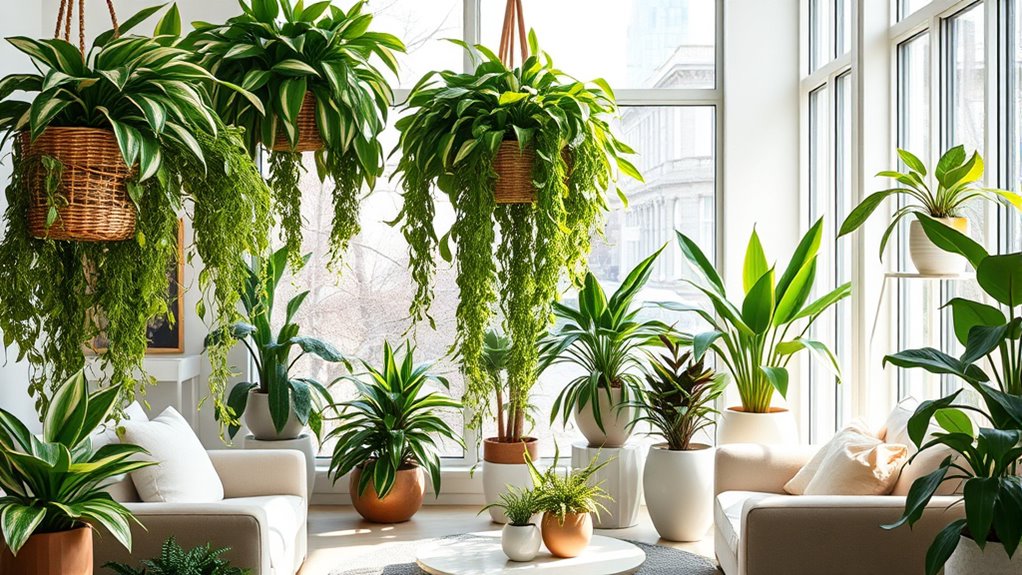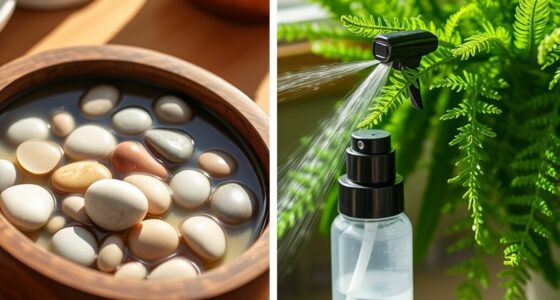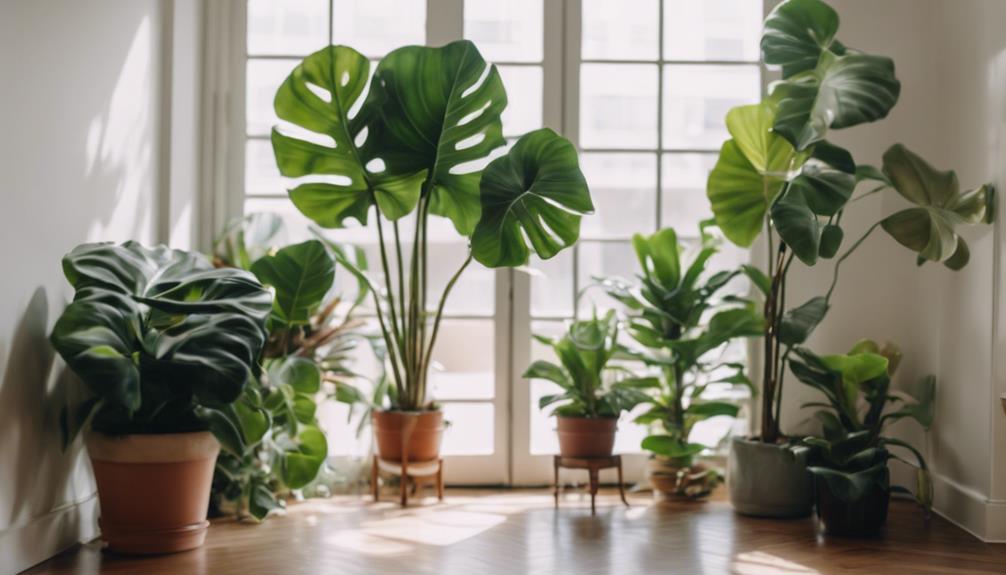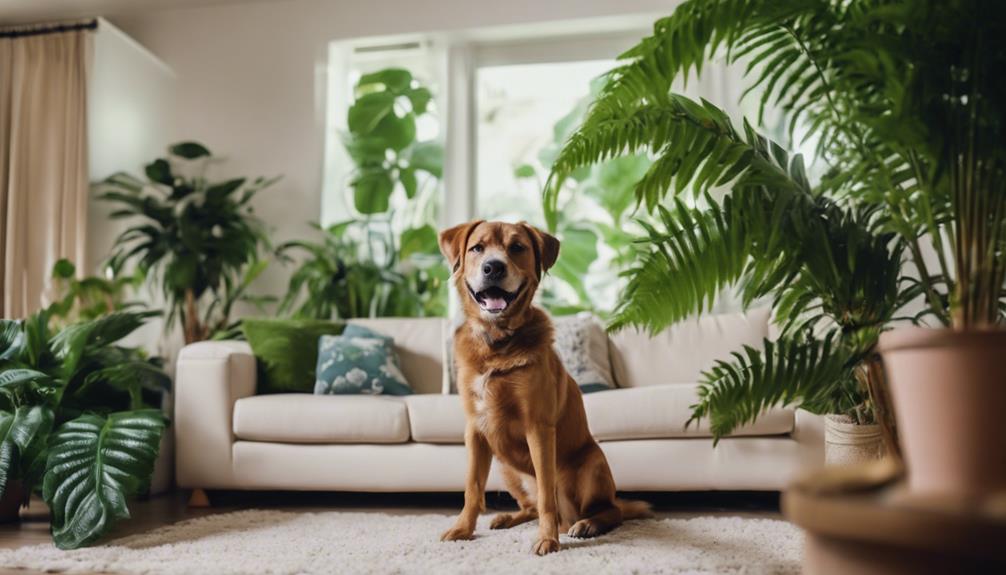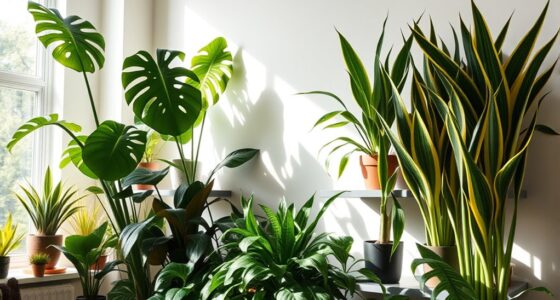Looking for pet-safe indoor plants you’ll actually love? You can enjoy vibrant greenery without worrying about your pets’ health by choosing plants like spider plants, Boston ferns, or parlor palms. These low-maintenance options add natural beauty while being safe if chewed. Thinking beyond the basics? There are other stylish, non-toxic choices you might not know about. Keep exploring to discover how to create a lush, pet-friendly space your furry friends will enjoy too.
Key Takeaways
- Opt for pet-safe indoor plants like spider plants, Boston ferns, and parlor palms that are both attractive and non-toxic.
- Incorporate stylish plant stands and elevated pots to keep plants out of pets’ reach and prevent nibbling.
- Verify the toxicity status of all plants before bringing them indoors to ensure pet safety.
- Choose low-maintenance, pet-friendly options such as prayer plants and certain succulents for easy care.
- Creating a lush, pet-safe indoor space enhances your home’s beauty while keeping your furry friends safe.
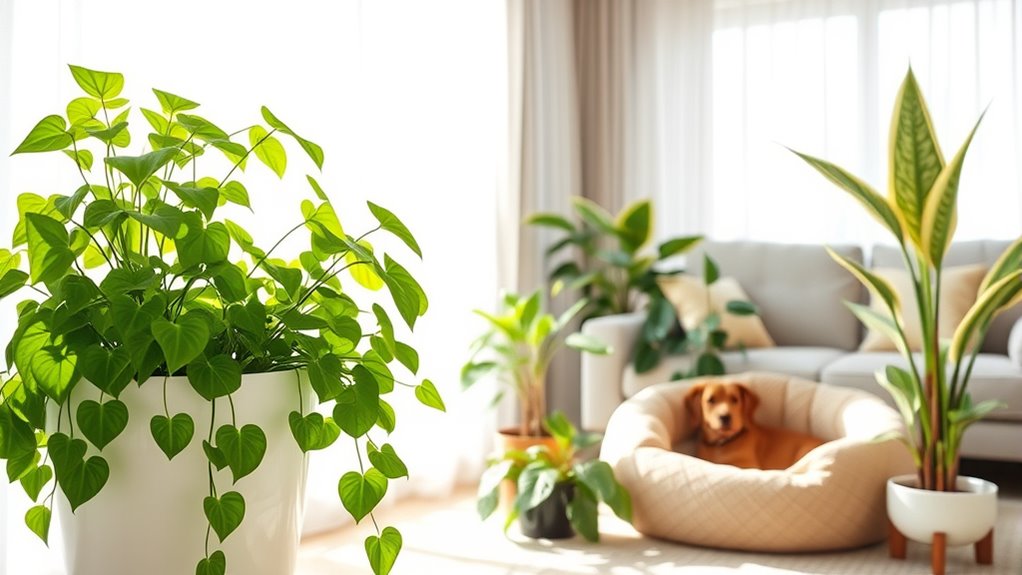
If you have pets and want to brighten up your home, choosing safe indoor plants is essential. Many popular houseplants can pose serious risks because of plant toxicity, especially if your curious cat or playful dog decides to nibble on them. Thankfully, there are plenty of pet-friendly decor options that look beautiful and keep your furry friends safe. When selecting plants, it’s important to verify which ones are non-toxic and pose no threat if your pet chews or eats a leaf. This way, you can enjoy lush greenery without constantly worrying about accidental poisoning or your pet’s health.
Choose safe indoor plants to keep your pets healthy and your home stylish.
You might be surprised to learn that many common indoor plants are safe for pets. For example, spider plants, Boston ferns, and parlor palms are all known for their pet-friendly qualities. These plants not only add a touch of nature to your living space but also won’t harm your pets if they decide to investigate or taste a leaf. Incorporating these into your decor means you can create a vibrant, lively environment that’s both stylish and safe. Plus, they tend to be low-maintenance, making them perfect for busy households.
Another good option is the prayer plant, which boasts striking foliage and is considered non-toxic to pets. It’s a great choice for adding a splash of color and texture without risking your pet’s health. Additionally, plants like the baby rubber plant and certain succulents are generally safe, but always double-check specific varieties, as plant toxicity can vary. When designing your pet-friendly decor, consider placing these plants in elevated or out-of-reach spots to prevent constant nibbling, but rest assured, if accidents happen, they won’t result in poisoning or serious health issues. Also, understanding permanent vs. temporary hearing loss can help you choose plants that are safe and non-toxic, ensuring a long-lasting, healthy environment for your pets.
Choosing pet-safe indoor plants isn’t just about avoiding danger; it’s about creating a space that feels welcoming and safe for everyone. With so many lovely options available, you don’t have to sacrifice style for safety. Use decorative pots and plant stands to showcase your greenery, and incorporate these plants into your everyday decor with confidence. When shopping, always verify that the plants you select are non-toxic, and keep your pets supervised around new plants until you’re sure they’re safe. This approach ensures your home remains a peaceful oasis, where your pets can explore freely without risking their health.
In the end, making mindful choices about plant toxicity means you can enjoy the calming benefits of indoor greenery without worry. Pet-friendly decor isn’t just a trend — it’s a practical way to nurture a beautiful, pet-safe environment. By choosing the right plants, you create a healthier, happier home for everyone, furry friends included.
Frequently Asked Questions
How Often Should I Water Pet-Safe Indoor Plants?
You should water your pet-safe indoor plants based on their watering schedule and soil moisture. Typically, check the soil every one to two weeks, and water when the top inch feels dry. Avoid overwatering, as it can lead to root rot. Adjust frequency depending on the plant type, season, and indoor conditions. Keeping an eye on soil moisture guarantees your plants stay healthy and happy without risking your pets’ safety.
Can Pet-Safe Plants Help Improve Indoor Air Quality?
Imagine fresh, clean air filling your living space, contrasting the smog outside. Pet-safe plants actively improve indoor air quality through air purification and toxin reduction, creating a healthier environment for both you and your furry friends. These plants naturally filter out pollutants, making your home safer and more inviting. Their presence not only beautifies your space but also promotes better breathing, helping you feel more energized and relaxed every day.
Are There Any Pet-Safe Plants That Thrive in Low Light?
You’re wondering if pet-safe plants can thrive in low light conditions. The good news is, many low light plants are also pet friendly greenery. Plants like the snake plant, pothos, and ZZ plant adapt well to less sunlight, making them perfect for shady spots. These pet-safe indoor plants not only survive in low light but also add lush, safe decor for your pet-friendly home.
How Do I Prevent My Pets From Damaging Indoor Plants?
Think of your plants as delicate dancers on a stage, needing the right cues. To prevent your pets from damaging them, focus on strategic plant placement—high shelves or hanging baskets keep plants out of reach. Combine this with consistent pet training, rewarding good behavior and redirecting curiosity. This way, your indoor garden remains a peaceful oasis, and your pets learn to respect the green performers without trampling their performance.
Are Organic Fertilizers Safe for Pet-Safe Indoor Plants?
You wonder if organic fertilizers are safe for pet-safe indoor plants. Yes, they generally are, since organic fertilizers use natural ingredients and avoid harmful chemicals. When you choose organic options, you help protect your pets from toxic substances while nourishing your plants effectively. Just make certain you follow application instructions carefully, keep fertilizers out of your pets’ reach, and opt for reputable brands to maintain pet safety and healthy indoor greenery.
Conclusion
Now that you know which indoor plants are safe for your furry friends, you can create a lush, pet-friendly oasis without sacrificing style. Remember, even in this modern age, a little greenery can make your space feel like a cozy cottage from a Dickens novel—minus the dust. So go ahead, pick your favorites, and enjoy a beautiful home where both you and your pets can thrive. After all, a happy pet makes for a happy home!
